Fake, Spurious or otherwise "Unauthenticated" Brasses
R.J. Bradshaw
This article is not necessarily the opinion of the society as a whole.
The Editor would like to thank all those members who have sent in emails and letters of encouragement and support praising the society for its coverage of these spurious or "unauthenticated" brasses which have surfaced in recent times. It is an issue, which generates a lot of discussion, some of it heated, and it is our intention to focus on these brasses more and more in the future, so that eventually, the awareness will be such that there will be little to be gained by advertising these brasses for sale at all. Note also our newest publications on the subject, "All About Engraving on Horse Brasses", (2013) and More About Engraving on Horse Brasses (2015) which are now availlable in our Shop link (above) at a nominal price to all collectors.
Left; Amongst the first of these, "unauthenticated" brasses to emerge in recent times were these fairly simple railway types as seen here, which sold well in the early days. Their initial acceptance led the perpetrators to prod uce brasses which became more and more sophisticated as time went on, though in the early years, most tended toward a certain simplicity, which rendered the earlier ones very believable indeed. Regarding these early types however, the editor has received a letter from a member who first encountered these back in the 1980's and stated that;
uce brasses which became more and more sophisticated as time went on, though in the early years, most tended toward a certain simplicity, which rendered the earlier ones very believable indeed. Regarding these early types however, the editor has received a letter from a member who first encountered these back in the 1980's and stated that;
"I remember the time when the LYR brasses first made their entrance (with the bump in the centre) nobody had even heard of one; next thing they were coming out of the woodwork. I would not have one in my collection, [tho
ugh] I obtained one and showed it to (name supplied) who was a big railway collector, who had never see
n one, though he had been collecting railway brasses for many years"
Such types later included hame plates (see below) from most, if not all of the pre-grouping, railway companies, with and without the "award" legend, as well as a few purporting to be genuine brewery, and other, spurious
award items also. Another early type were Leeds City Corporation engraved types, (LYC in script) and some with the legend, Wade Maker Bradford, also engraved onto common cast, and stamped brasses with a central bump.
 Because so many have surfaced in recent years, the discussion regarding such brasses has obviously increased and some collectors have remarked how this unpleasant trend seems to be on the rise of late. This latter comment however is not entirely accurate as it is known that many of these brasses were engraved up to twenty years ago and are only surfacing now because, as older members have passed away or given up collecting, numerous examples have surfaced and are finding their way on to the market especially via the relatively recent, electronic auction facilities, as well as the more traditional outlets.
Because so many have surfaced in recent years, the discussion regarding such brasses has obviously increased and some collectors have remarked how this unpleasant trend seems to be on the rise of late. This latter comment however is not entirely accurate as it is known that many of these brasses were engraved up to twenty years ago and are only surfacing now because, as older members have passed away or given up collecting, numerous examples have surfaced and are finding their way on to the market especially via the relatively recent, electronic auction facilities, as well as the more traditional outlets.
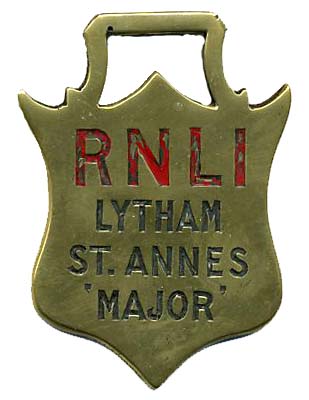

Left; Other early brasses to be engraved with spurious detail were these R.N.L.I brasses, which followed a very interesting article in the N.H.B.S. Journal of the time about a mare called "Smart" whose gallant service in the floods of 1953 earned her a specially engraved, R.S.P.C.A. award brass, which was presented to her proud owners. This obviously planted a few seeds in certain, fertile minds, which produced the two brasses above, and another inscribed, R.N.L.I "Bobby" Whitby, which surfaced again briefly in c.2005, but disappeared again soon after.
It is also to be regretted that one of the worst problems encountered in recent times is the upset and division that these brasses are still creating within our membership. Especially when such fakes are identified to unwitting or inexperienced collectors, which frequently causes bad-feeling, and can often breed malcontent. Sadly, this is a prime example of the more insidious effects that such brasses are still capable of generating. That being said, I would encourage any member to constantly return to this page on our website, which, along with our newest books, "All About Engraving on Horse Brasses", "More About Engraving on Horse Brasses" and periodic articles in the journal, are the the only publications that contain updates and any useful tips on how to identify such items, which we continue to uphold as accurate as we can make it, as a consensus of the current thinking of a group of concerned and experienced collectors to which we cordially invite further input into our growing database of these, "unauthenticated" brasses, which even at the time of writing, are continuing to appear on ebay, and on other auction sites.
 Left; somewhat more sophisticated were these ploughing, and other "award" brasses, which were probably even researched to add authenticity. It is now common knowledge amongst collectors of twenty years or more, (or those who are regulars at the N.H.B.S meetings) of a certain collector who was canvassing for plain brasses who mostly acquired them, by paying unusually high prices because, as he stated, "he had a friend who wanted to make up a full-set of harness with them" In recent months two seperate collectors, of long standing, informed Ian Jones and myself of this fact, and several years ago, one N.H.B.S. founder member, told the author that:
Left; somewhat more sophisticated were these ploughing, and other "award" brasses, which were probably even researched to add authenticity. It is now common knowledge amongst collectors of twenty years or more, (or those who are regulars at the N.H.B.S meetings) of a certain collector who was canvassing for plain brasses who mostly acquired them, by paying unusually high prices because, as he stated, "he had a friend who wanted to make up a full-set of harness with them" In recent months two seperate collectors, of long standing, informed Ian Jones and myself of this fact, and several years ago, one N.H.B.S. founder member, told the author that:
"Alarm bells first began to ring when I saw a brass, which I was absolutely certain had been one of mine, that I had sold to him with the exception that this one, which was then being shown around by its its proud new owner, now had
writing all over it."
Indeed, any collector(s) still in any doubt that this pratice actually occured, should take a look at the RSPCA Halifax diamond-shaped brass, and the, Edward Prince of Wales 1907, brasses (below) to see the evidence of this dubious practice, one of which was seen by more than twenty collectors at a meeting (and in a photograph on a martingale before it was stripped of its brasses) and the other which is an out-and-out forgery, which got its "historical facts", hilariously wrong.

Left, the skill of the e
ngraver was superb
as evidenced by these examples, on their original leathers. Such examples were often "found" (what luck!!) with matching award hame-plates engraved to the same winner.....of course they were!!
In later years, the perpetrators became more and more bold, and martingales appeared with three or more brasses engraved with,
Mid Lancs Ploughing Association
and a martingale containing four "awards" from, Fleetwood Horse
Parade
.
In early 2013 the editor received an email from a founder member in support of an article in the Journal (no74) of January 2013 regarding four "unauthenticated" brasses (below) which were the subject of much heated debate the writer stated that;
(This photograph is included here by kind permission of their former owner)
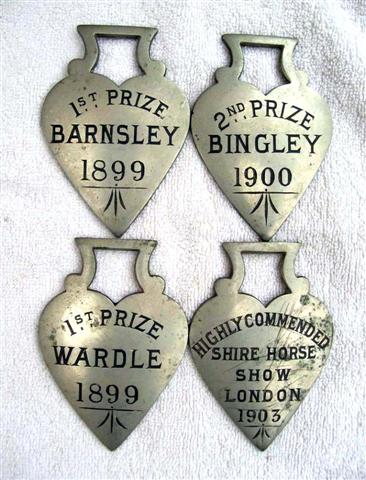 Because a large number of these spurious brasses have surfaced in the last few years, awareness has obviously been raised, but understandably, many have caused a great deal of consternation. Some collectors (who bought brasses from the perpetrators) now realising that some of the brasses in their collections are fakes, have tried to recoup their losses by attempting to unload brasses on the internet, before the inevitable warnings are flashed to members via word of mouth or by email on the membership grapevine.
Because a large number of these spurious brasses have surfaced in the last few years, awareness has obviously been raised, but understandably, many have caused a great deal of consternation. Some collectors (who bought brasses from the perpetrators) now realising that some of the brasses in their collections are fakes, have tried to recoup their losses by attempting to unload brasses on the internet, before the inevitable warnings are flashed to members via word of mouth or by email on the membership grapevine.
During these discussions the author has been asked by several members to give the subject a permanent profile here on our website in the hope that this will further raise awareness and act as a warning to collectors both old and new of something that has dogged the horse brass collecting community far too long now, though the existence of such items may well be considered important by analysts of material culture, as indicators of the popularity of a collecting field in the time which they were made
Why Fakes?
Indeed, it may well be argued that any collecting subject has reached its status as a truly popular -and therefore lucrative- pastime when fakes or reproductions begin to appear. In other collecting fields this has been a common state of affairs for many years and where there is a known demand/shortfall for a certain popular type of antique or collectable, there are usually a few entrepreneurial types who will quickly identify and supply it. Indeed, it is often said that nature abhors a void and so, with human nature being what it is, some spurious brasses should have been an expected, or even inevitable outcome. Even though most collectors detest them, fakes do have, as strange as this first may seem, an object value entirely of their own.
In her publication entitled, Interpreting Objects and Collections, the Editor, Susan Pearce informs us that,
Fakes are a way of subverting the established order of object value through the arts of deception, but from another point of view they are legitimate historical documents which tell as much (and sometimes more) about the time in which they were made. They capture two important aspects of objects: they relate directly to notions of object value, usually in a straightforward salesroom price sense, and they are deeply implicated in the often malicious personalities of the fakers and the weaknesses of collectors (p.92).
In the same publication, one of the contributing authors, Mark Jones writes,
Where there are fakes it is clear that there was a booming market in the things thus imitated: fakers are above all creatures of the market, and move quickly to take advantage of the high prices produced by a new fashion before the development of expertise makes their task more difficult or, worse still, their activities undermine the market altogether (p.94).
The subject of fake horse brasses is not exactly a new one either. In 1916 H.R. Carter wrote of this problem and how some modern output was especially age-treated on the face and artificially blackened on the reverse. These brasses however, are easily spotted and are only of passing interest to the beginner but it is the more skilled attempts that create the worst problems.
In this vein, and as early as 1912, the writer Charles Rowed warned collectors of the existence of such things (see NHBS Journal 57 p.19). This is a hurdle where even the most experienced collectors can sometimes fall, and this kind of fake-brass would, most likely, be a genuine example, with actual harness wear made unique by the later addition of other, even contemporary, parts perhaps, or indeed, an engraved name, a date, or a trade calling. These brasses were of course as eagerly sought after by collectors in the early years of the last century as they are today.
 In the June 2000 issue of the society journal, Horse Brass, (no. 48) the subject of these forged pieces received early coverage both in the editorial and in a short article, by the then editor, Ran Hawthorne, who wrote that, “This [practice] is not widespread but because of the type of brass and the prices being asked, collectors are being deceived and defrauded of large sums of money” (p.1) The brasses in question at this time were those pictured left, which as the article further stated, “Started life as a plain sun-disc swinger, and a plain “hide shaped brass” (p.2.) -which, we will remember- were just the type of brasses that were being sought out by certain individuals at this time, the result of which, we will examine further.
In the June 2000 issue of the society journal, Horse Brass, (no. 48) the subject of these forged pieces received early coverage both in the editorial and in a short article, by the then editor, Ran Hawthorne, who wrote that, “This [practice] is not widespread but because of the type of brass and the prices being asked, collectors are being deceived and defrauded of large sums of money” (p.1) The brasses in question at this time were those pictured left, which as the article further stated, “Started life as a plain sun-disc swinger, and a plain “hide shaped brass” (p.2.) -which, we will remember- were just the type of brasses that were being sought out by certain individuals at this time, the result of which, we will examine further.
It is now common knowledge amongst veteran NHBS members that, during the late 1980's-early-1990’s, a small ring of dishonest collectors sought to cash in on the high prices expected of rare types of brasses, by having certain examples engraved by a skilled tradesman. These brasses, which were genuine 19th Century examples, were usually of the type, which offered plenty of space for the engraver to work further detail upon them. From testimony gathered in recent years, it is believed that an elderly artisan was engaged to do the work who was known to one of the perpetrators, who may now have passed away. There can be little doubt however, regarding his skill as an engraver, and he should be held in no way to blame as this was simply a job of work to him, for which he was probably paid handsomely for, as something of a supplement to his pension perhaps? However, as we will examine, his handiwork can, with care, be discerned with a little practice.
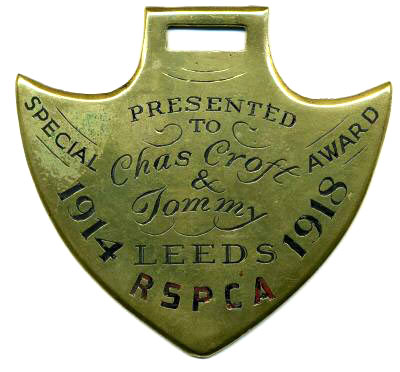 Left; a perfect example of one that appeared on ebay in the early days of its existence, which outlines the usual criteria of a very rare "spade" shaped, cast brass which are often described by experienced collectors, as having, "too much information". Note also how an early type brass is used here for dates which are probably thirty years later, Why? and indeed, if such a "special" brass was commissioned by a local RSPCA inspector, why diddnt he choose a contemporary or more standard type?
Left; a perfect example of one that appeared on ebay in the early days of its existence, which outlines the usual criteria of a very rare "spade" shaped, cast brass which are often described by experienced collectors, as having, "too much information". Note also how an early type brass is used here for dates which are probably thirty years later, Why? and indeed, if such a "special" brass was commissioned by a local RSPCA inspector, why diddnt he choose a contemporary or more standard type?
When such brasses are offered however, some collectors knowing their rarity, do purchase these and have the supurious detail polished off. Below; are three early types c.1870's-1880's with a later 20thc dates engraved on them, including two early "spade" types which were spoiled by these people, yet again, with later, highly unfeasible dates engraved upon them. A founder-member collector testified to the "King 1902" being "unauthenticated" and is fairly certain he saw it before, it was re-engraved.
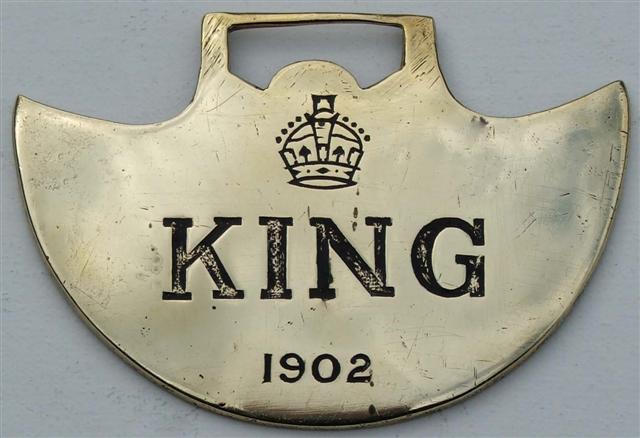

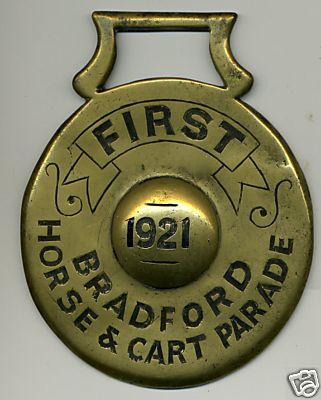
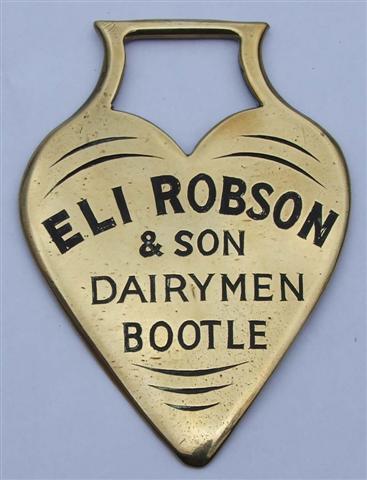
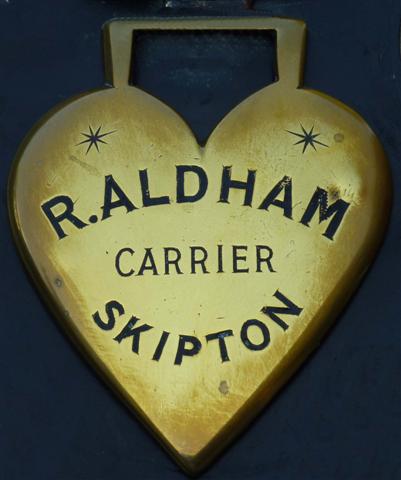

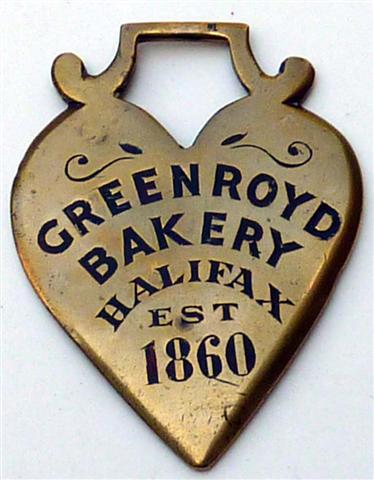
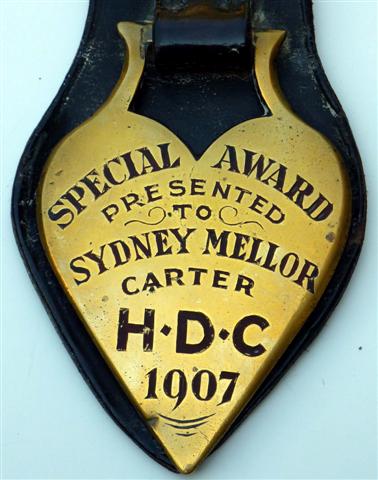
Plain heart brasses were particulaly suited to this nefarious trade including (above) four further "unauthenticated" types using genuine harness worn brasses, including one (bottom left) engraved in situ to retain its original leather face-piece
to add authenticity. Note
the characteristic freshness of each piece. Ask yourself why this should be so, especially
as, if each piece were in fact genuine, why none have become worn through regular polishing. In almost all cases, the faked detail purports to be northern in origin, mainly Lancashire or Yorkshire, with the very occasional
exception.
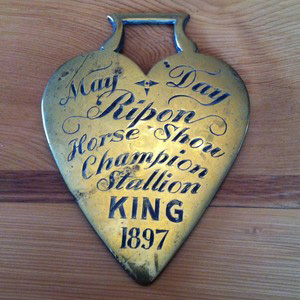
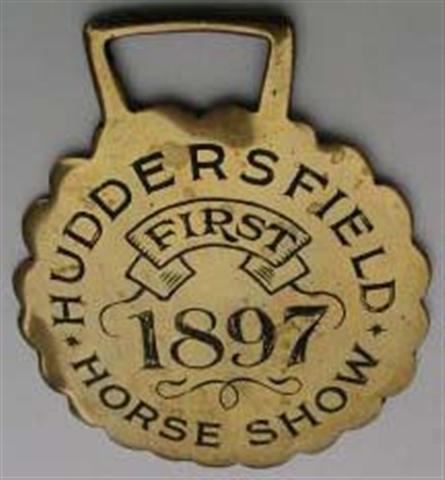
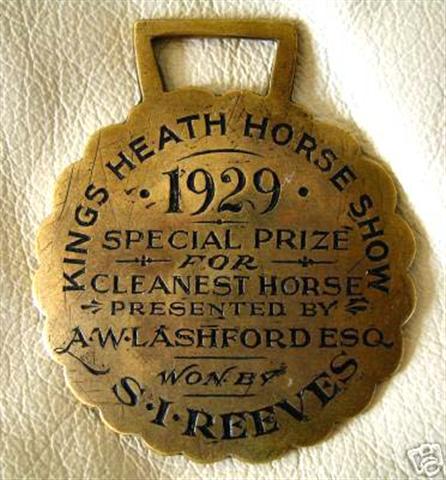 Above; three more faked types using genuine old brasses. Note the northern location again of the central and right hand brasses. The Huddersfield and Kings Heath brasses appeared for sale on the internet some years ago but were withdrawn after several complaints. A genuine Kings Heath award brass is included below as a comparison, as is the genuine owner brass to the right of it. Note the wear on the brass, below right, which is commensurate with its age. The genuine Kings Heath brass however is the exception and has remained very fresh. Indeed, here we can see when comparing the two, just why these brasses have caused such consternation in recent years. However, the genuine Kings Heath below, is engraved on a thinly stamped brass of the time and has leather-work that is also contemporary with the date, whereas the above centre brass is a much older, cast brass.
Above; three more faked types using genuine old brasses. Note the northern location again of the central and right hand brasses. The Huddersfield and Kings Heath brasses appeared for sale on the internet some years ago but were withdrawn after several complaints. A genuine Kings Heath award brass is included below as a comparison, as is the genuine owner brass to the right of it. Note the wear on the brass, below right, which is commensurate with its age. The genuine Kings Heath brass however is the exception and has remained very fresh. Indeed, here we can see when comparing the two, just why these brasses have caused such consternation in recent years. However, the genuine Kings Heath below, is engraved on a thinly stamped brass of the time and has leather-work that is also contemporary with the date, whereas the above centre brass is a much older, cast brass.
The Kings Heath brass is also a notable exception to the general, Northerly aspect of these fakes. This is because the genuine Kings Heath brass was bought in an antique sale where the buyer claimed that others were present. This however was a complete falsehood as several buyers had carefully checked the lots offered for sale and had seen only one. The buyer simply had one or more copies made and retained the original for himself, until he himself, gave up collecting, sold his brasses, and therefore revealed the lie.
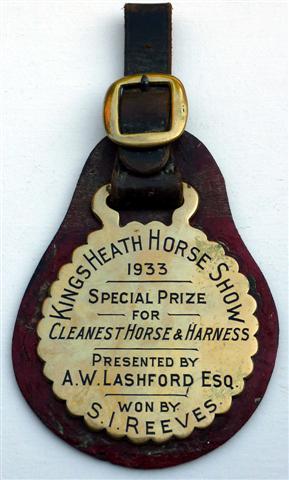
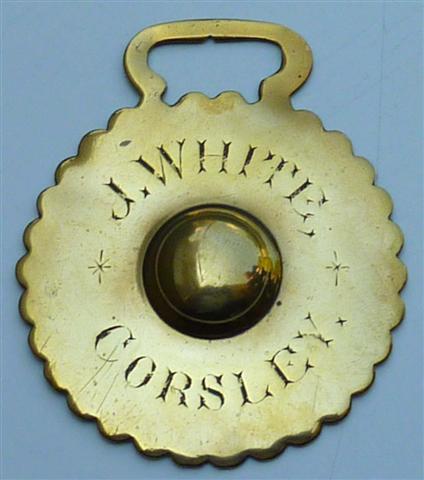
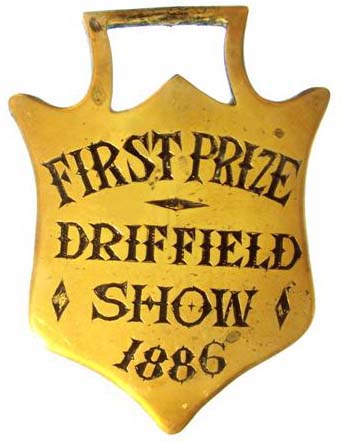
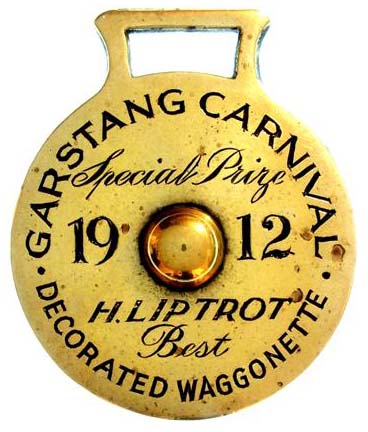
Above a genuine Kings Heath brass and (second left) a genuine owners brass engraved post c.1880 -after stamped brasses were made available to horsemen-, included here to show a brass with genuine wear to the engraved legend. Unlike the two brasses on the right which are also early types; one with an integral stud (far right) c.1880 with, yet again lettering purporting to be 1912 (yeah right!), and a plain shield type with somewhat uneven lettering, which is often another characteristic of these "unauthenticated" types.
So what are we to do in the face of such blatant dishonesty? Perhaps the first avenue of inquiry however, is to employ the common sense, which sometimes goes out of the window in the undisciplined excitement that collectors may feel when faced with the chance of acquiring such a "rare" example, especially when other collectors are present which of course, "ups" the pressure. The obvious questions then, that all collectors should ask themselves are:
1. Why do ALL of these brasses always seem so fresh?
2. Why do certain details/engravings look distinctly similar despite the many miles that seperate the locations on the brasses?
3. why do so many of them seem too good to be true?
The answers are simple; because they are relatively fresh; they were done by the same hand, and because they ARE too good to be true. Always remember, when faced with such examples the age old adage of, Caveat Emptor, or Buyer Beware, and if an example seems too good to be true, then it probably is. Better to treat all examples of engraved brasses as highly suspicious and then use your acumen to convince yourself otherwise and DO NOT rely on those individuals who purport to be experts after only a few years of limited experience, especially when those collectors have either been caught out by, or do not bid on such items themselves.
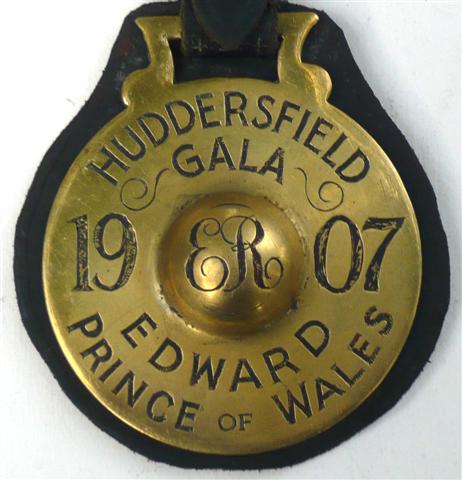
 Left; another two fakes, where the similarity of "hand" is difficult to ignore; especially in the numerals in the dates. The Huddersfield Gala Award Brass on the left however is a typical example of "cashing in" on two types of horse brass, i.e. the "Royalty", and the "Award", only the fakers did not do their home work , because Edward was not Prince of Wales in 1907, he was King of course, and his son George (later George V) was actually Prince of Wales. Collectors often note how certain aspects of these faked brasses are almost too good to be true, and are just a little too well embellished with added swirls and stars and other details that genuine brasses often did not have.
Left; another two fakes, where the similarity of "hand" is difficult to ignore; especially in the numerals in the dates. The Huddersfield Gala Award Brass on the left however is a typical example of "cashing in" on two types of horse brass, i.e. the "Royalty", and the "Award", only the fakers did not do their home work , because Edward was not Prince of Wales in 1907, he was King of course, and his son George (later George V) was actually Prince of Wales. Collectors often note how certain aspects of these faked brasses are almost too good to be true, and are just a little too well embellished with added swirls and stars and other details that genuine brasses often did not have.
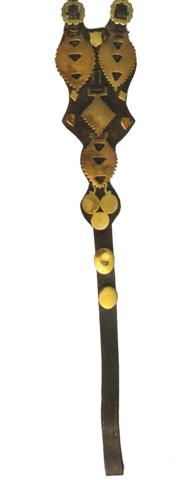
 Discussed at the 2010 AGM in Walsall was perhaps one of the saddest examples of this dubious practice (left), which can be seen mounted on this wonderful old martingale (far left), which now only exists as a photograph. This rare martingale had several examples of cast brasses mounted on it, of the type which required much hand-finishing. This is also the type of artefact that probably indicates a smaller output from a regional workshop, and was a valuable, and possibly even one-off example of the type of folk-art which flourished in the horse brass era.
Discussed at the 2010 AGM in Walsall was perhaps one of the saddest examples of this dubious practice (left), which can be seen mounted on this wonderful old martingale (far left), which now only exists as a photograph. This rare martingale had several examples of cast brasses mounted on it, of the type which required much hand-finishing. This is also the type of artefact that probably indicates a smaller output from a regional workshop, and was a valuable, and possibly even one-off example of the type of folk-art which flourished in the horse brass era.
At the time (at a past AGM in Walsall), its then owner experienced some trouble selling it and later decided to cut the brasses off to sell individually realising that he could make more money that way. Recently, the central diamond pattern re-surfaced from a breaking collection but now with the lettering added to it, as seen above. At the 2010 AGM, interested members were offered a further chance to handle and observe the type of rare brass that has been altered and made even "rarer" to command a much higher price. Plainly evident here is exactly the same "hand" seen in most of the other brasses on this page, featuring the same type of specialised event; the same northern location, and of course, the same team of forgers. What is most disturbing however is that a valuable example of localised brass-work and harness ware has been irretrievably lost for nothing better than short term monetary gain, and as a result this wonderful piece of historical evidence is now gone forever. The brass however was purchased by a NHBS member who had the spurious detail polished off.
Of the examples included here, all have been used because experienced collectors were, at one time, taken in by them, and are used here with their permission, with the exception of the fake RSPCA 1914-18 "Spade" brass, the similar type with the name Gates engraved upon it, the Kings Heath (1929) brass and the Huddersfield (1897) brass which are downloaded images taken from auction facilities on the internet whilst these were in the public domain, and therefore devoid of copyright.
The NHBS Stand on Fakes.
The problem of these fake brasses is one that is often discussed amongst members and at committee level and the general consensus of opinion which becomes painfully clear to committee members especially, is that, as a society, the NHBS cannot possibly police the market or act as some sort of market regulator. What we can do however is report on these brasses from time to time to raise awareness against the existence of such items and, if and when such items do appear, simply state that, “we cannot authenticate”, brasses such as those shown in this article. Collectors’ today therefore, need to be very wary of engraved brasses, perhaps more than any other type. As ever, experience is the key and in his publication, Horse Brasses, the author George Hartfield wrote,
Most collectors start as jackdaws, gathering everything they come across- later culling the frauds and the poorer specimens. It is probably better not to try to short-circuit this. To make mistakes, and then to live with them, is the finest way of getting to know your subject in any collecting field (p.62).
This is a factor that most serious collectors - including the author - would agree with, and although many of us believe that such experience, -and common sense- is something you cannot teach, it is neverleless, far better to keep abreast of current matters in any collecting field, in order to avoid the nastier, more expensive mistakes such as those that we see here.
So how does the modern day collector achieve this? Perhaps the only method of combating spurious items in any collecting field however, has always been the knowledge and experience that some call connoisseurship. In order to fully understand their chosen subject, it always assists a collector once a detailed study of manufacturing processes is properly understood. This means that many avenues of investigation may be attempted before a detailed knowledge is achieved, which may include a study of the materials from which an item is constructed and how these mature over time, as well as an understanding of the fabrication processes.
Most publications on the subject do contain something about manufacture, which is always welcome to the beginner, but there can be little doubt that the collector will learn so much more from the careful observations made from the handling of genuine examples. Collectors tend to know each other, talk amongst themselves and band together especially in the face of such blantant fakery. Many have now taken a stand against this practice and awareness has been raised and pretty soon there will be little to be gained in any attempt to sell these brasses at all.
This is where a good society comes in very useful and a collector of horse brasses of course has the benefit of the National Horse Brass Society where new members can converse with other collectors and reputable dealers and rely on their advice and experience. In recent years the NHBS has developed an excellent rapport with its members by providing a number of venues each year where members old and new can meet up and purchase or exchange brasses and keep abreast of what is happening on the market. Indeed, periodic articles in the journal -and on this website- are the only publications that contain any useful tips on how to identify such items, which we continue to uphold as accurate, as an ever growing consensus of the current thinking of a group of concerned and experienced collectors. Indeed, we cordially invite further input to our growing database of these spurious brasses, which even at the time of writing, are continuing to appear on certain, electronic auction facilities.
We sincerely hope however, that any horse brass collectors are not put off by these fake brasses, for after all, as the original article in 2000 stated; it is not a widespread practice, and several of the perpetrators have since passed on, which includes the engraver himself, So if the occasion rises where a collector is faced with such articles if there is ever any doubt;
1. Always ask for a signed receipt.
2. Always agree on a “money back” guarantee.
3. Dont believe the usual lie that, " another collector has shown an interest in it, and is coming back" If he or she truly had, it wouldnt still be there would it?
And, if neither is forthcoming, ask yourself why, and leave the article behind.